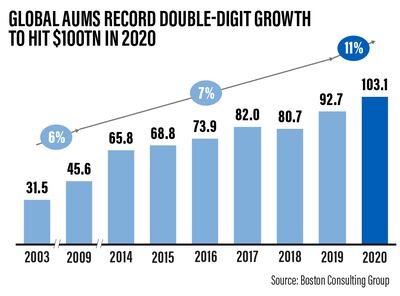Assets under management in the Middle East grew by 11 per cent to $1.2 trillion in 2020, compared with $1.1tn in 2019, despite coronavirus-induced economic headwinds, according to a report by management consultancy Boston Consulting Group.
The growth was primarily due to an increase in the assets of sovereign wealth funds as global markets rebounded and oil prices gradually recovered from a steep drop in the first half of the year, the Global Asset Management 2021: the $100 Trillion Machine report found.
Many of the wealth funds had high exposure to developing and emerging market equities, both of which fared well as financial markets bounced back, the study said.

“Much like every sector, the resilience of the asset management industry was tested in 2020, with initial outbreak disruption and subsequent economic tailwinds presenting a period of sizeable uncertainty for the industry and its incumbents,” said BCG managing director and partner Harold Haddad.
“However, the Middle East has prevailed in the face of adversity and it is now apparent that the region has entered 2021 in a position of strength following healthy returns.”
Wealth funds owned by regional governments such as Abu Dhabi's Mubadala and Saudi Arabia's Public Investment Fund have been on an investment spree over the past year, snapping up assets in sectors such as technology, automation and health care.
Mubadala's AUMs grew by 5 per cent from Dh853 billion in 2019 to Dh894bn at the end of last year while PIF's AUMs during the reporting period stood at $430bn.
Automation, digitisation and artificial intelligence are the top investment themes for global institutional and family office investors, according to a recent study by Bahraini asset manager Investcorp.
The total value of assets under management globally hit $103tn at the end of 2020, up 11 per cent from $93tn in 2019, as strong market performance and favourable net flows buoyed the industry, the BCG report found.
In other regions, North America's AUMs grew by 12 per cent to reach $49tn while Europe and Asia recorded growth of 10 per cent and 11 per cent, respectively, according to BCG’s 19th annual study of the global asset management industry.
At the global level, net inflows for the asset management industry stood at $2.8tn in 2020, or 3.1 per cent of the total AUMs at the beginning of the year – compared with a historical average between 1 per cent to 2 per cent over the previous decade, the report said.
Retail investors were the main driver, contributing net flows of 4.4 per cent in 2020, double the figure for institutional investors.
Global retail AUM portfolios grew by 11 per cent in 2020, representing 41 per cent of the global asset pool valued at $42tn.
Institutional investment also grew at a similar pace to $61tn, or 59 per cent of the global market, the BCG study found.
“The key contributors to aggregate flows globally were fixed-income products, which received additional support from various government stimulus programmes and money market funds,” the report said.
However, profitability for asset managers was largely flat across the board last year in comparison with 2019, as costs and fee compression kept operating profits hovering at about 34 per cent of net revenue, the BCG report said.
Most traditional asset classes recorded double-digit growth in 2020, outpacing their five-year and 10-year historical averages, the research found.
Among traditional active assets, those managed by large-cap equity funds and domestic government-based fixed-income funds grew by 11 per cent over the course of last year. Money market funds were up 12 per cent.
Meanwhile, passive investments became popular during the coronavirus pandemic. The index-tracking products grew their AUMs by 17 per cent globally during 2020 through a combination of strong net inflows and market growth, the report said.
Exchange-traded funds had a particularly strong year. Both equity ETFs and fixed-income ETFs beat their 10-year average growth rates, capturing AUM growth of 21 per cent and 24 per cent, respectively, the study said.
“On the revenue side, new asset classes, particularly within private markets and alternatives in general, will be crucial to growth during the next several years,” the BCG report said.







